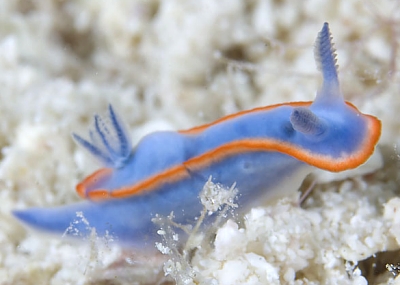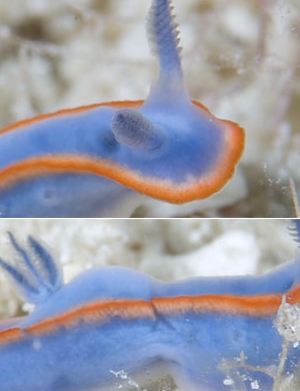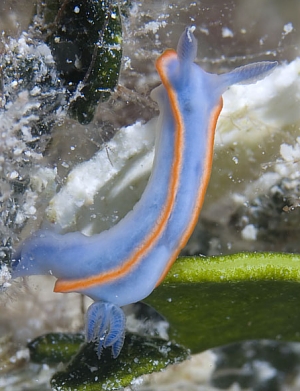Hypselodoris nyalya from Kay Largo, Florida
August 10, 2007
From: Paul Osmond

Hi Bill,
Had a quick trip to Florida for business and had a chance to dive for a few days in my old backyard in Key Largo, Florida. During a dive on Conch Reef, we observed this specimen of Hypselodoris nyalya moving across the coral reef.
Locality: Key Largo, 20m, Florida, USA, Atlantic, 13 May 2007, Coral Reef Ledge. Length: 25mm. Photographer: Paul T. Osmond.
Seems to be my privilege to have now seen this species in more than one location. This one was significantly larger than any of the previous grouping that I found in Bimini a few years ago and I got much better images this time around as well.
Yours,
Paul
www.deepseaimages.com
marriard@deepseaimages.com


Dear Paul,
Thanks for these nice photos. I have included a couple of close-ups to show what look like mantle glands around the mantle edge. They form a continuous whitish band of small glands right around the mantle. Looking back in earlier photos I can see signs of the same whitish band in those specimens as well. This is quite puzzling because Marcus & Marcus (1967), when they described this species, specifically mention and illustrate a quite different arrangement of mantle glands - " the notal border bears glands .. two antero-lateral groups and a postbranchial semicircle of seven glands.. " and their drawing shows large spherical glands like we find in Hypselodoris, Risbecia and related genera. It was originally placed in Chromodoris but I suggested it should be moved to Hypselodoris and Ortea et al (1996) suggested it should be moved to Risbecia. Certainly the Forum records of it feeding on Dysidea etheria (see Rudman & Bergquist, 2007) support its relationship to the Hypselodoris - Risbecia branch of the chromodorids, as do the shape of the radula teeth as reported by Marcus & Marcus. However, if this whitish band is the mantle glands, then I think the whole anatomy of this species needs to be looked at, in particular its reproductive system, which we know nothing about, and its position in the chromodorids re-evaluated.
-
Marcus, Er. & Marcus, Ev. (1967) American opisthobranch mollusks. Part 1, Tropical American opisthobranchs. Studies Tropical Oceanography, Miami, 6 (1-2): 1-137. (Figs 1-150, Pl.1, figs 1-9)
-
Ortea, J., Valdes, A. & Garcia-Gomez, J.C. (1996) Review of the atlantic species of the Family Chromodorididae (Mollusca: Nudibranchia) of the blue chromatic group. Avicennia (Suppl. 1): 1-160.
-
Rudman, W.B. & Bergquist, P.R. (2007) A Review of feeding specificity in the sponge-feeding Chromodorididae (Nudibranchia: Mollusca). Molluscan Research, 27(2): 60-88
Best wishes,
Bill Rudman
Related messages
-
Chromodoris nyalya
From: Bill Gomez, June 19, 2006 -
Hypselodoris nyalya feeding
From: Marina Poddubetskaia, March 8, 2004 -
Hypselodoris nyalya from Florida
From: Linda Ianniello, November 18, 2003 -
Hypselodoris nyalya from Bimini, The Bahamas
From: Paul Osmond, June 7, 2003 -
Hypselodoris nyalya from the Bahamas
From: Larry Townsend, May 29, 2003 -
Nudibranch from Southern Bahamas
From: Paul Young , September 10, 2002
